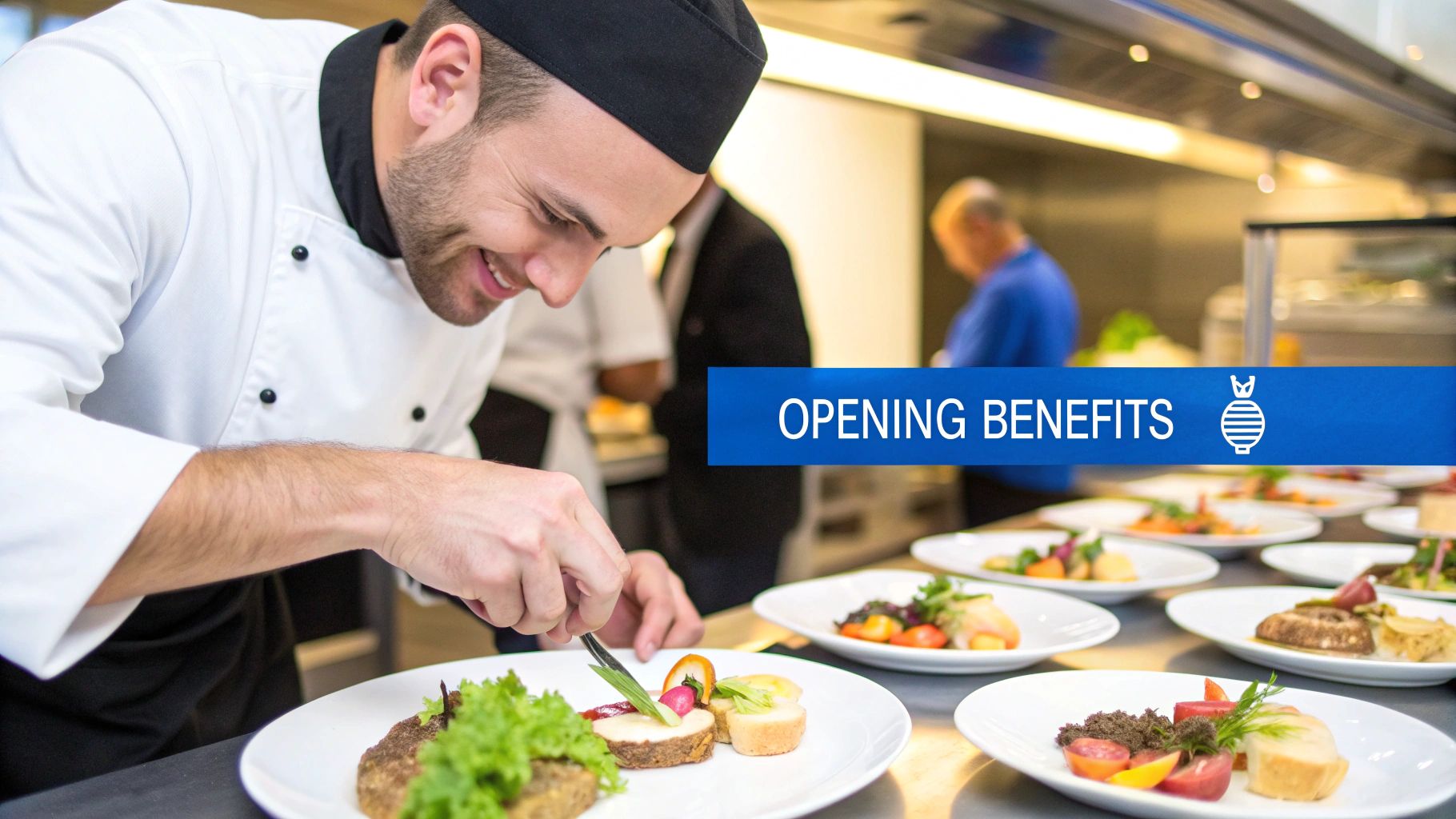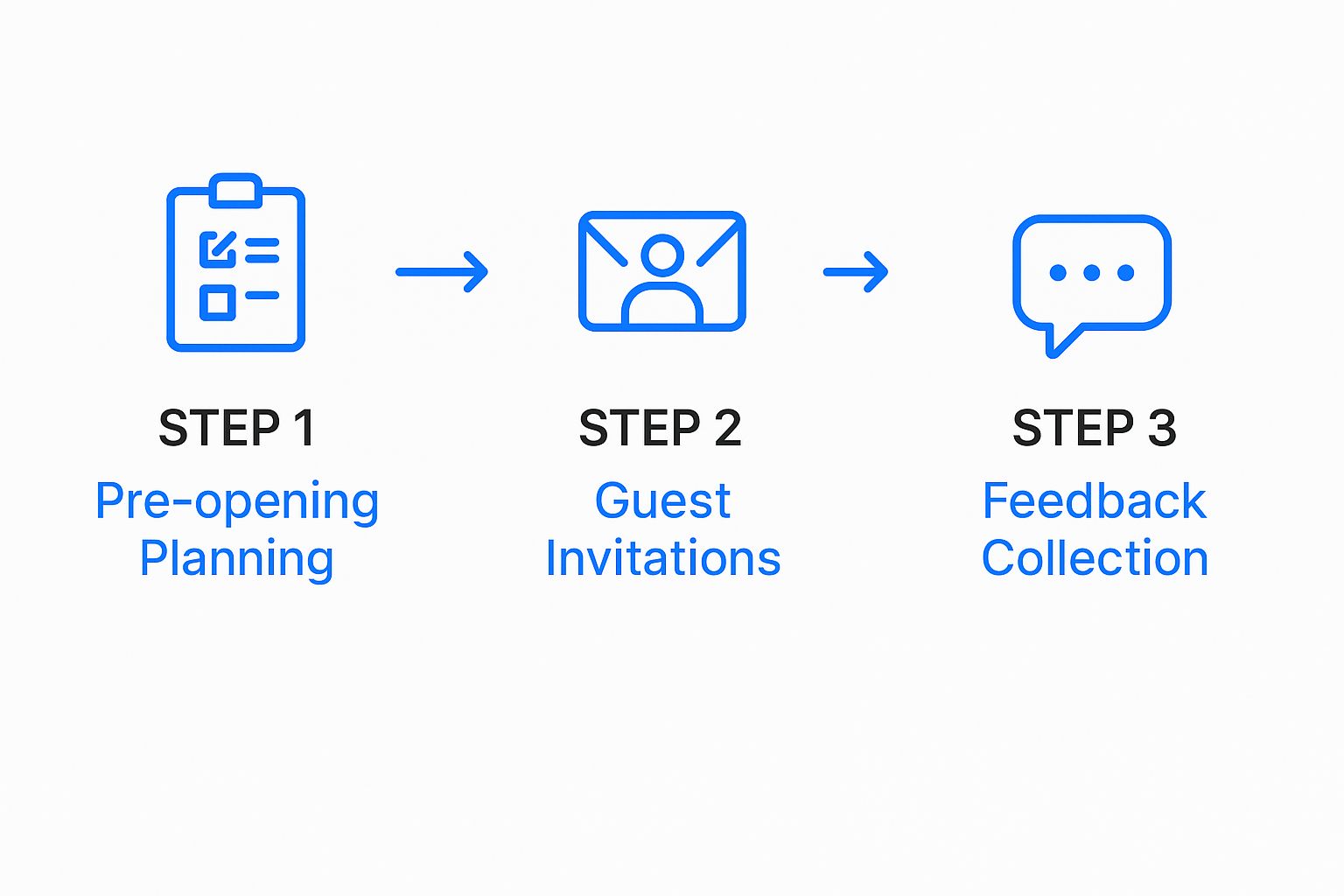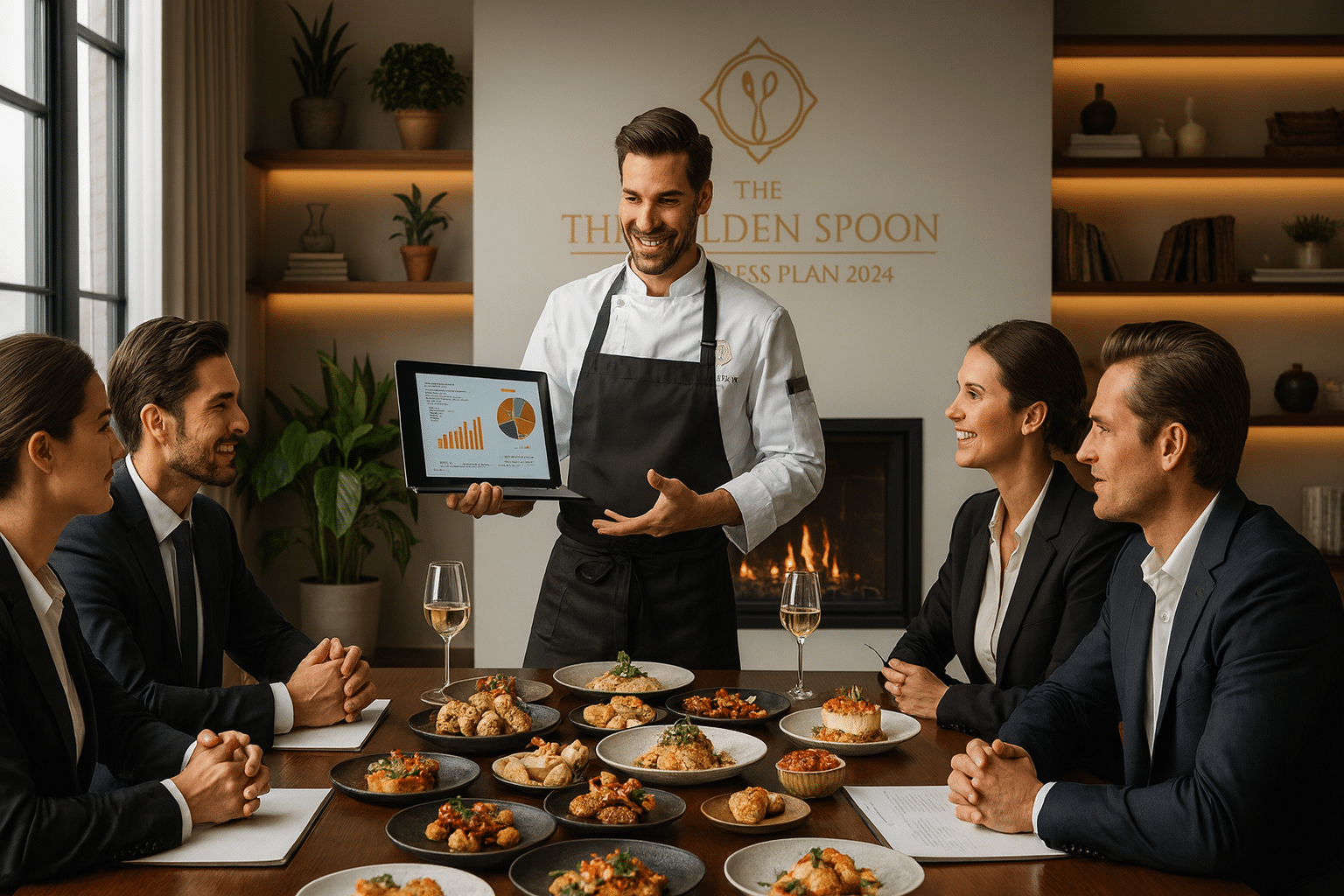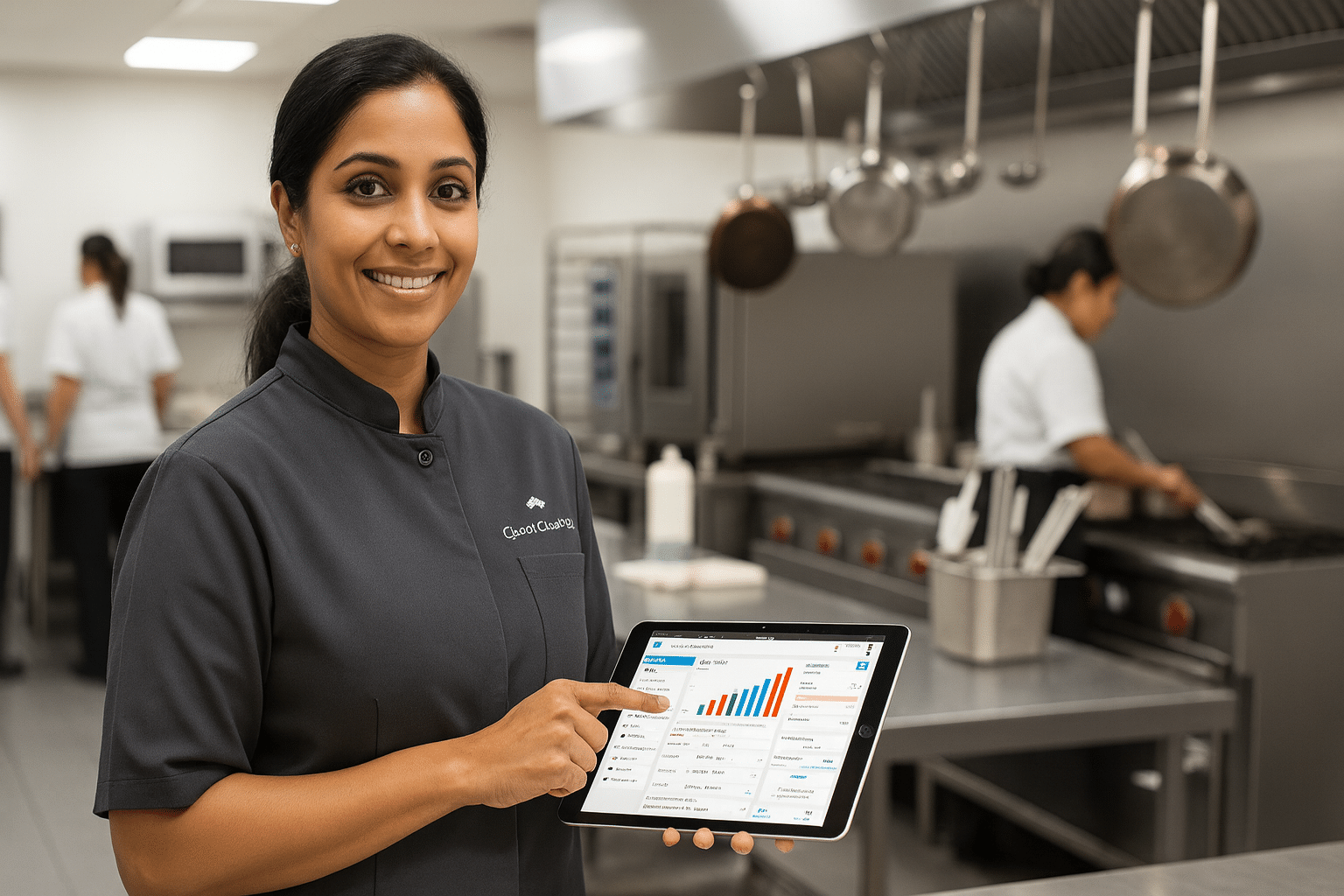You've poured your heart, soul, and life savings into your new restaurant. The paint is fresh, the kitchen gleams, and the staff is hired. But before you throw open the doors to the public, there's one crucial step you can't afford to skip: the soft opening.
Think of it as the final dress rehearsal before your big debut. It’s a controlled, invite-only preview that gives you a chance to see how everything really works in a low-pressure setting. This is where you iron out the wrinkles before the whole world is watching.
Your Restaurant's Dress Rehearsal: The Soft Opening Explained
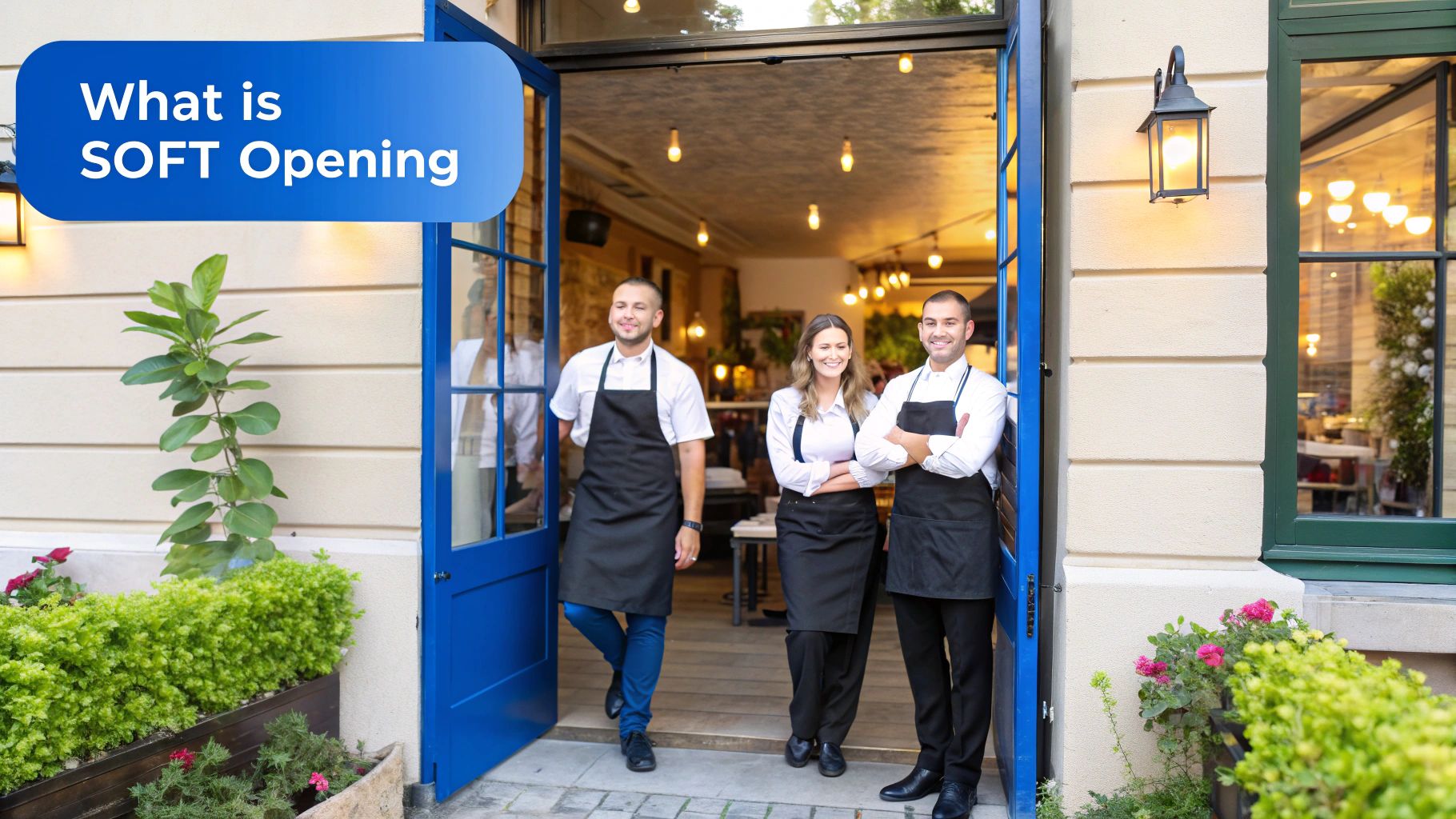
No Broadway show would ever premiere without a few full dress rehearsals. The director needs to see the lights, the actors, and the set changes come together live. A restaurant's soft opening is exactly that—it's your opportunity to test your team, your menu, and your service flow under real-world conditions, but without the harsh glare of the public spotlight.
This trial run, which can last anywhere from a couple of days to a few weeks, happens before your grand opening. You invite a small, select group of people to dine with you, letting you spot operational hiccups and get honest feedback.
Who Gets an Invite?
Your guest list is everything. You aren't just hosting a party; you're conducting invaluable market research with a friendly audience. A smart guest list includes:
- Friends and Family: They're your built-in support system and will be more forgiving of any initial stumbles.
- Neighboring Business Owners: This is a great way to build goodwill in the community right from the start.
- Local Media and Food Bloggers: Getting them in early can generate some fantastic, authentic buzz before you officially open.
A soft opening is your golden ticket to fix a clunky POS system, a confusing menu, or a dish that takes forever to get out of the kitchen—all behind closed doors. It turns potential public failures into private learning experiences.
Soft Opening vs. Grand Opening Key Differences
It's easy to confuse the two, but they serve completely different purposes. The soft opening is all about testing and refining. The grand opening is about making a big, loud, public splash.
Here’s a quick breakdown to make the distinction crystal clear:
| Feature | Soft Opening | Grand Opening |
|---|---|---|
| Audience | Invite-only: friends, family, local influencers | Open to the general public |
| Purpose | Test operations, train staff, get feedback | Generate buzz, attract new customers |
| Atmosphere | Controlled, low-pressure, focused on learning | High-energy, celebratory, promotional |
| Marketing | Minimal to none; private invitations | Heavy promotion, media announcements |
| Menu | Often limited to test key dishes | Full menu on display |
Ultimately, the soft opening is your practice run, ensuring that when the curtain finally rises for your grand opening, you're ready to deliver a flawless performance. For a deeper dive, check out these essential tips for a successful soft opening.
Why a Soft Opening Is Your Most Important Pre-Launch Strategy
Think of it this way: launching your restaurant without a soft opening is like a theater troupe skipping dress rehearsal. It’s a huge, unnecessary gamble. This isn't just some pre-opening party; it's a controlled, strategic test run designed to expose all the hidden problems that only surface during a live service.
You might find out your signature dish, brilliant on paper, is far too complex to execute quickly, sending ticket times through the roof. Maybe that beautifully designed floor plan creates a massive bottleneck right by the bar, frustrating both staff and customers. These are exactly the kinds of issues you want to catch and fix now, in a low-stakes, forgiving environment.
A Live Training Ground for Your Team
One of the biggest wins from a soft opening is giving your staff a real-world training session. You can talk about a dinner rush all you want, but nothing prepares a team for the pressure quite like actually living through one.
This is where your front-of-house and back-of-house crews learn to communicate, sync up their timing, and build the rhythm essential for a smooth operation. It’s their chance to build confidence as a cohesive unit before the real critics—the paying public—walk through the door.
The real value is simple: fixing problems behind closed doors is far cheaper and less damaging than dealing with public failures and negative online reviews.
Perfecting the Customer Journey
From the moment a guest walks in to the second they pay the bill, every single interaction matters. A soft opening lets you experience this entire journey firsthand and fine-tune every touchpoint. It's your single best opportunity to see your restaurant through your customers' eyes and make adjustments.
In the United States, there are over one million restaurants, and a staggering 9 out of 10 are small businesses with fewer than 50 employees. For these independent owners, managing risk is everything. A soft opening isn't a luxury—it's a vital play for long-term survival in an incredibly tough market. To get a better handle on the challenges small restaurants face, you can discover more insights about restaurant industry statistics on WebstaurantStore.
Your Step-by-Step Soft Opening Playbook
Pulling off a great soft opening isn't about throwing a party; it's about executing a well-organized plan. Think of it less like a single event and more like a multi-stage dress rehearsal, where each step builds on the last. A methodical approach is the only way to make sure you're testing what really matters and gathering feedback that actually leads to improvements.
This is your chance to direct the show before the real critics arrive. From clarifying your purpose to hand-picking the right guests, every decision counts. Let's walk through how to ensure your team, your menu, and your space are truly ready for opening night.
Define Your Core Objectives
Before you even think about sending an invitation, you have to know what you're trying to accomplish. What’s the number one thing you need to learn?
Are you mainly trying to stress-test the kitchen to see if the line can handle a dinner rush? Or is your focus squarely on the front-of-house team to gauge the quality of service and the pacing of the dining experience?
Nailing down your goals is, without a doubt, the most important first step. Your objectives will dictate every other decision you make, from who you invite to what you put on the menu.
You might focus on a few key goals:
- Menu Validation: Getting honest, unfiltered opinions on your dishes, portion sizes, and pricing.
- Operational Workflow: Finding those inevitable bottlenecks—whether it's between the kitchen and servers or at the host stand.
- Staff Training: Giving your new crew a live, low-stakes environment to practice in before the pressure is really on.
- Technology Testing: Making sure your POS system, kitchen displays, and payment terminals are working perfectly.
The infographic below breaks down the key phases of planning your event.
As you can see, a successful event moves logically from the initial strategic planning to managing your guests and, finally, to gathering the data you need to make smart changes.
Curate a Strategic Guest List
Your guest list is a tool, so build it strategically. You need a mix of supportive insiders and influential outsiders.
Start with your inner circle—friends and family who will give you honest feedback without crushing your spirit. They’re your safest audience for working out the most obvious kinks right at the beginning.
Once you’ve done a run-through with them, expand your list. Invite local business owners, community leaders, and maybe even a few friendly food bloggers. These guests offer a more objective viewpoint and can start generating positive word-of-mouth before you even open your doors. Their early support can be a huge asset as you look for ways to increase restaurant sales right from the get-go.
Be crystal clear in your invitation. Let guests know this is a trial run and their constructive feedback is the whole point. This gives them permission to be honest critics, which is exactly what you need.
Running the Event and Gathering Actionable Feedback
When the big day finally arrives, your gut instinct will be to jump in and fix every little hiccup. Resist that urge. Your most important job during the soft opening is to step back and simply watch.
Think of yourself as a director observing a dress rehearsal. Your focus should be on the big picture, seeing how all the moving parts work together in a real-world scenario. Keep an eye on the flow from the host stand, the timing from the kitchen, and the rhythm of the servers on the floor.
This is your one chance to spot the bottlenecks you’d never find on paper. Are entrees lagging ten minutes behind appetizers? Is one section of the dining room consistently getting slower service? These are the real-world problems you’re here to uncover.
Collecting Feedback That Drives Change
Vague compliments like "everything was great!" are nice to hear, but they won't help you fix anything. To make real improvements, you need specifics. Learning how to get customer feedback effectively is the entire point of this exercise.
Give your team the tools they need to succeed here. You could use simple feedback cards left on the table or even a QR code that links to a quick digital survey. Most importantly, train your servers to ask specific questions and to genuinely listen to what your guests are saying.
Your goal isn't just to collect feedback—it's to capture fresh, honest insights the moment they happen. The most valuable information is often shared in unguarded, immediate reactions.
Once the last guest has walked out the door, gather your entire team for a debrief. This is non-negotiable. While the night is still fresh in everyone’s minds, talk through the highs, the lows, and the totally unexpected moments.
This immediate huddle is where the magic happens, allowing you to catch details that would be forgotten by morning. Walk out of that meeting with a clear, prioritized list of what needs to be fixed. You'll be turning the night's lessons into a solid action plan for a truly grand opening.
Turning Insights Into a Flawless Grand Opening
The soft opening is done. Now, the real work begins. This is your moment to take all that amazing feedback you gathered and turn it into a solid action plan for your big launch. Don't think of the comments as criticism; see them for what they are—a treasure map guiding you to a smoother, more successful restaurant.
This is the time to really dig into the data, look for patterns, and figure out what to tackle first. Did a few different tables say the risotto was too salty? It's time to get back in the kitchen and tweak that recipe. Was the bar constantly slammed and falling behind during the busiest hour? You’ll need to rethink your bar setup, workflow, or maybe even add another bartender.
The whole point is to catch and fix the problems that could have torpedoed your grand opening before the general public walks through the door. You only get one chance to make a first impression, so make it a great one.
Creating Your Action Plan
Going through the feedback haphazardly won't cut it. You need a systematic plan that clearly outlines each issue, who is responsible for fixing it, and a deadline for getting it done.
Your priority list might look something like this:
- Menu Tweaks: Adjusting recipes for better flavor, making sure a dish comes out the same way every time, or simplifying a process to speed up prep.
- More Staff Training: Running drills to close service gaps, or providing extra practice on the POS system to prevent errors.
- Floor Plan Reconfiguration: Shifting a few tables or moving a service station to get rid of a frustrating bottleneck you noticed during the rush.
This kind of detailed preparation isn't just a nice-to-have anymore; it's becoming standard practice. The global foodservice market is valued at over $3.09 trillion, and with that kind of competition, you can't afford to learn on the fly after you're officially open. Owners are pushed to get everything right from day one.
Making these data-driven fixes is how you close the gap between a dress rehearsal and a flawless public debut. If you're looking for a complete roadmap for all the moving parts, you might find our checklist for opening a restaurant incredibly helpful.
Common Questions About Restaurant Soft Openings
Even the best-laid plans run into questions when you get down to the nitty-gritty of a soft opening. Getting these practical details right is what separates a smooth, productive trial run from a chaotic one. Let's tackle some of the most common questions that pop up.
Should We Charge Guests During a Soft Opening?
This is the big one, and there's no single right answer. A popular and very effective middle ground is to offer a hefty discount, maybe 50% off the final bill.
Another smart approach is to comp the food but have guests pay for their alcoholic drinks. This strategy helps you cover at least some hard costs while, more importantly, giving your entire payment system a full test run.
Here's the thing: asking guests to pay something often gets you more realistic, thoughtful feedback than a complete free-for-all. Whatever you decide, the key is to be crystal clear about the arrangement in your invitation so everyone walks in knowing exactly what to expect.
How Long Should a Soft Opening Last?
The timeline really comes down to what you need to accomplish. A soft opening can be anything from a one-night affair to a two-week marathon.
- A short event (1-3 nights): This is great for a final stress test. You can check your kitchen timing, service flow, and systems with a team that already has some experience under their belts.
- A longer period (1-2 weeks): This gives you a chance to do some serious, real-world training for new staff. It also lets you see how your operation holds up on a slow Tuesday compared to a slammed Friday night.
Think about how seasoned your team is and how complex your menu and service are. That will tell you how much time you need.
Who Are the Best People to Invite?
You want a strategic mix of people who can give you different kinds of feedback. Start with your inner circle—friends and family who you know will be honest but also have your back.
From there, branch out. Invite local business owners, community figures, and maybe even a few friendly food bloggers or local reporters. These guests bring a more objective eye and can start building that crucial word-of-mouth buzz. One group to steer clear of? The general public and professional food critics. Save them for when you're 100% confident and ready for the spotlight.
A smooth soft opening hinges on a reliable point-of-sale system that lets you test everything from the moment an order is placed to the final payment. Biyo POS is an all-in-one solution that helps you manage your menu, track sales as they happen, and process payments without a hitch. It ensures you've worked out all the kinks long before your grand opening. Discover how Biyo POS can support your launch.

